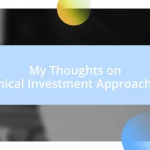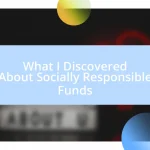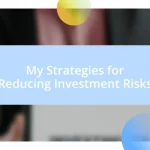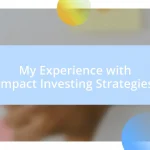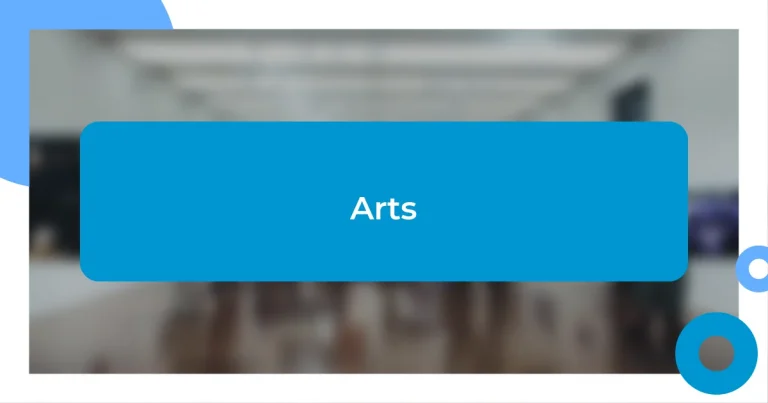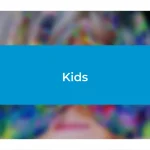Key takeaways:
- Establishing a forecasting culture involves creating a safe and collaborative environment where team members feel empowered to share insights and learn from both successes and failures.
- Utilizing the right tools, such as data visualization software and communication platforms, enhances forecasting accuracy and encourages continuous dialogue among team members.
- Measuring forecasting effectiveness through metrics and feedback fosters a culture of learning and adaptability, allowing teams to refine their processes and improve decision-making collaboratively.
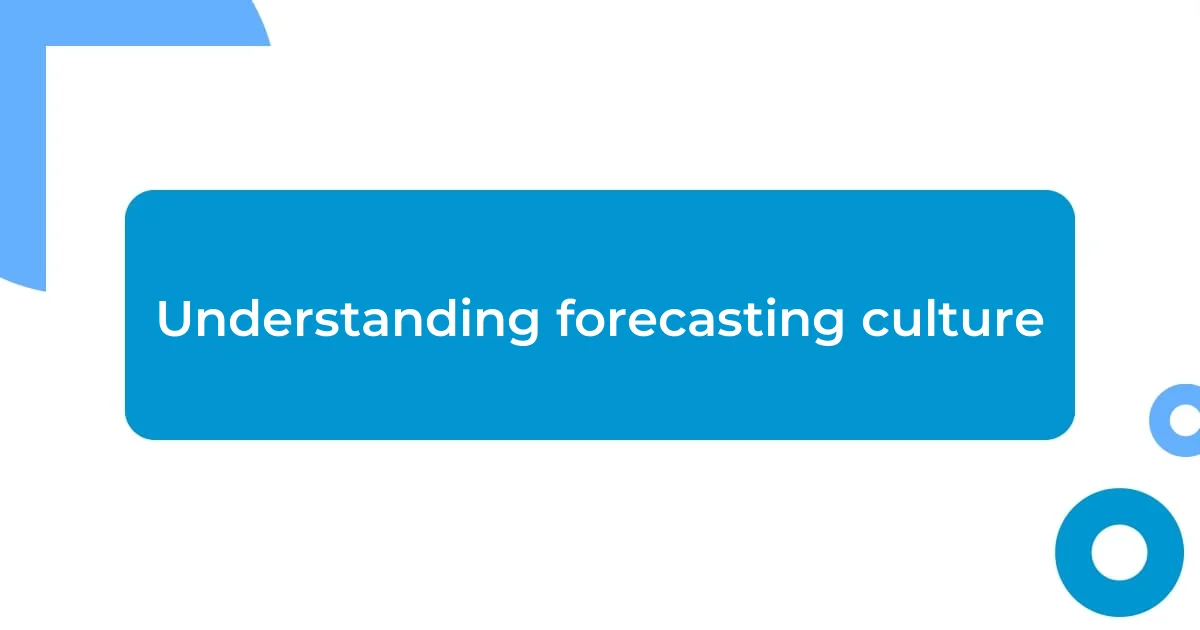
Understanding forecasting culture
A forecasting culture isn’t just about predicting numbers; it’s about fostering a mindset where everyone values data-driven decision-making. I remember when I first introduced forecasting at my workplace. Initially, colleagues were skeptical – they often relied on gut feelings rather than analysis. This change required nurturing an environment where asking questions and exploring data became the norm.
As I engaged more with my team, I saw how important it was to create a safe space for discussion. I held weekly meetings where we shared not just our forecasts but also the stories behind them — what worked, what didn’t, and why. Reflecting on those sessions, I realized that creating a forecasting culture is about building trust; when people feel confident in contributing their insights, the collective understanding deepens. Isn’t it fascinating how much richer discussions become when everyone feels their input matters?
Moreover, a successful forecasting culture thrives on continuous learning. I once heard a colleague say, “Failure isn’t the opposite of success; it’s part of success.” This perspective shifted our approach dramatically. We began viewing inaccurate forecasts not as setbacks, but as opportunities for growth. This mindset transformation ultimately boosted our team’s resilience and adaptability, illustrating that understanding forecasting culture is about embracing a journey, not just reaching a destination.
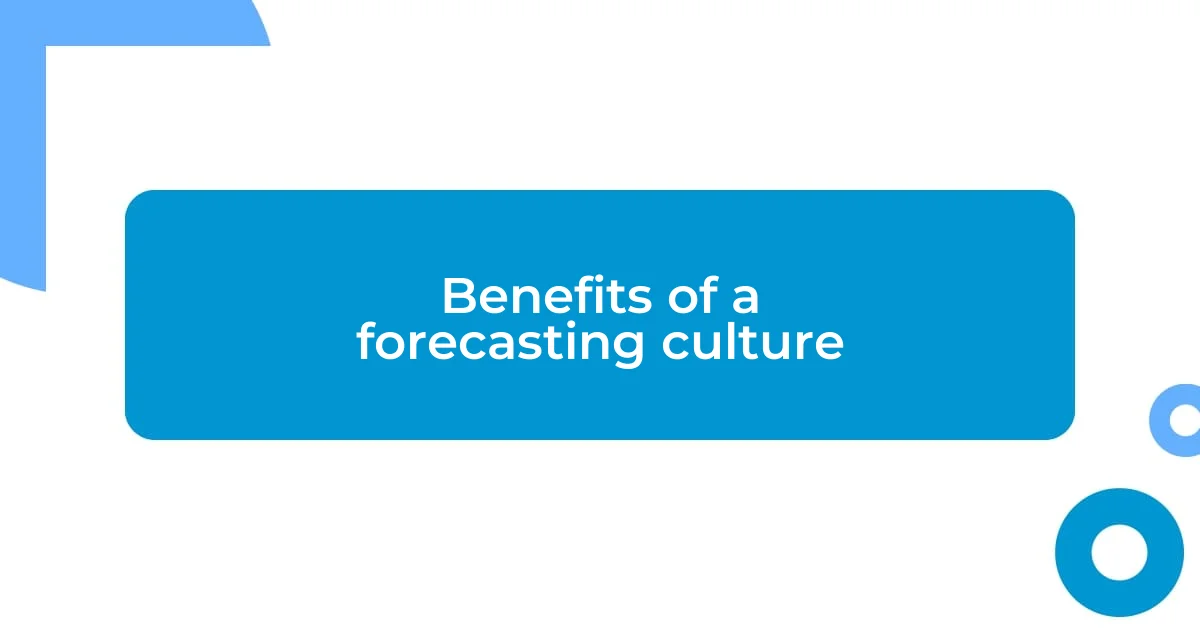
Benefits of a forecasting culture
A forecasting culture brings a multitude of benefits that extend beyond mere predictions. When I embraced this approach, I noticed a remarkable shift in confidence among my team members. They became more proactive and engaged in their roles. The sense of ownership over their contributions soared, leading to better collaboration. This empowerment not only drove more accurate forecasts but fostered a proactive mindset in our decision-making processes.
Here are some key benefits I’ve observed from cultivating a forecasting culture:
- Enhanced Decision-Making: Teams can make informed choices rooted in data, reducing knee-jerk reactions.
- Increased Accountability: With everyone involved in the forecasting process, individuals take pride in their outputs, promoting responsibility.
- Improved Communication: Regular discussions around forecasts create an open dialogue, breaking down silos and enhancing teamwork.
- Opportunities for Innovation: By analyzing past forecasts, teams can identify patterns and experiment with new approaches, driving continuous improvement.
- Boosted Confidence: Seeing their predictions take shape gives team members a sense of achievement, reinforcing their value within the organization.
I remember a time when we faced a significant market shift. Instead of panicking, our forecasting culture allowed us to analyze trends swiftly. This fueled our creativity to pivot and adapt, turning a potential setback into a strategic win. I truly believe that fostering this culture isn’t just beneficial; it’s essential for cultivating resilience and agility in today’s fast-paced environment.
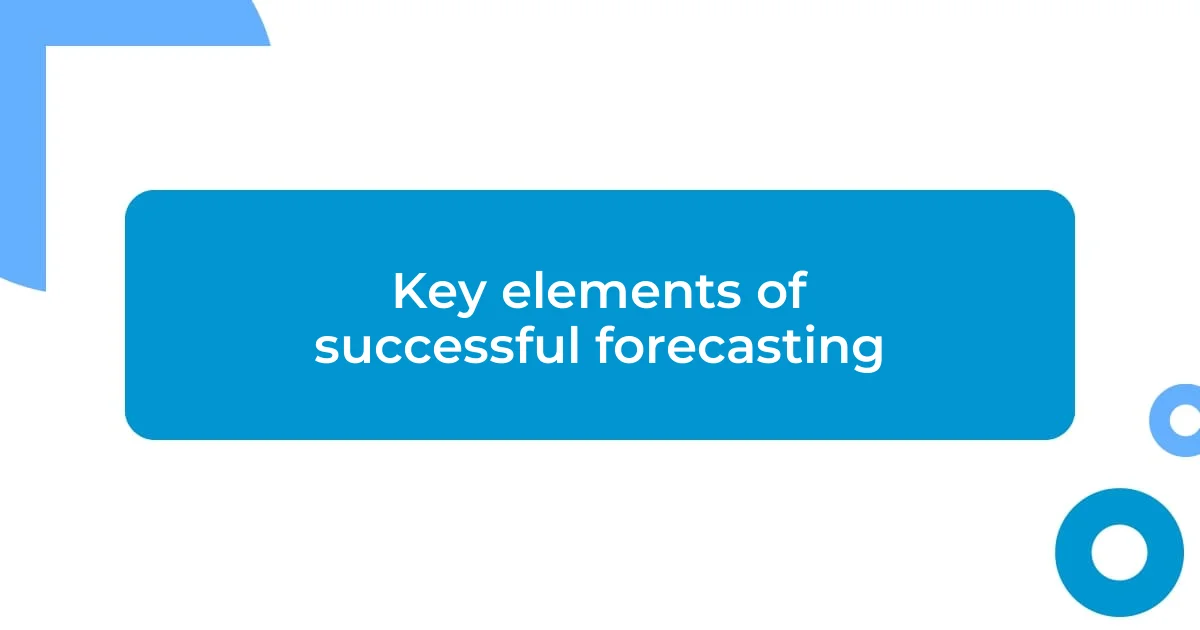
Key elements of successful forecasting
The core elements of successful forecasting revolve around collaboration, transparency, and adaptability. From my experience, engaging the entire team in the forecasting process is vital. I recall a pivotal moment when I invited team members from various departments to join our forecasting sessions. The diverse perspectives they brought to the table not only enriched our forecasts but also fostered a sense of collective ownership. This collaborative spirit significantly enhanced our accuracy, as we were no longer confined to a single viewpoint.
Transparency is another essential element that I can’t stress enough. When I first started sharing our forecasting data openly, it felt a bit daunting. However, I quickly noticed an incredible shift. People started to feel empowered to ask questions and share their thoughts, which turned our forecasting meetings into lively discussions. This openness led to deeper insights, driving better outcomes. It’s interesting how the act of sharing can unravel new ideas.
Finally, adaptability plays a crucial role in ensuring the forecasting process remains effective. I vividly remember how quickly we had to pivot our forecasts during the onset of a global event that disrupted all business norms. By using real-time data and adjusting our models accordingly, we managed to stay ahead of potential pitfalls. This willingness to reassess and reframe our forecasts allowed us to navigate uncertainty more effectively.
| Key Element | Description |
|---|---|
| Collaboration | Involves engaging diverse team members to enrich insights. |
| Transparency | Fosters open discussion, encouraging feedback and questions. |
| Adaptability | Allows for adjustments based on real-time data and changing conditions. |
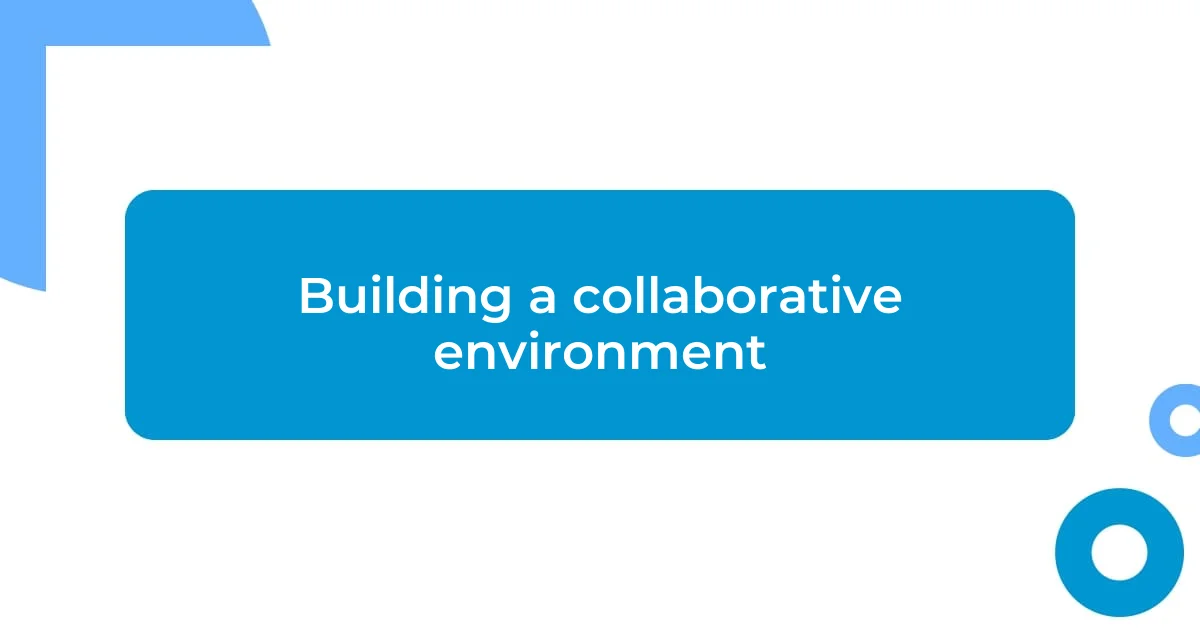
Building a collaborative environment
Creating a collaborative environment isn’t just about bringing people together; it’s about cultivating a space where every voice is heard and valued. I remember a particular brainstorming session that transformed our forecasting approach. One team member shared an unconventional idea from her previous job that shifted our perspective entirely. It was a simple thought, but it sparked a lively discussion, illustrating how each person’s experience can add layers of insight to our forecasts. Have you ever felt what it’s like to witness a team thrive on diverse opinions? It’s exhilarating!
In my experience, regular check-ins can significantly enhance collaboration. We established a rhythm of weekly meetings focused on forecasting updates. This routine not only kept everyone in the loop but also created an atmosphere of accountability where team members felt comfortable admitting when things didn’t go as planned. I found that encouraging vulnerability led to richer conversations, as we could explore challenges together rather than in isolation. Have you considered how time spent nurturing these dialogues can build a stronger team bond?
Empowering cross-departmental collaboration also plays a crucial role in this journey. I’ve seen firsthand how involving teams from finance, sales, and marketing opens up a wider lens for our forecasts. During one quarterly review, the sales team suggested adjustments based on real customer feedback. It was like flipping on a light switch, illuminating blind spots we didn’t know existed. When we embrace diverse perspectives like this, that’s when our forecasting truly evolves. How can we create more opportunities for such collaboration in our own teams?
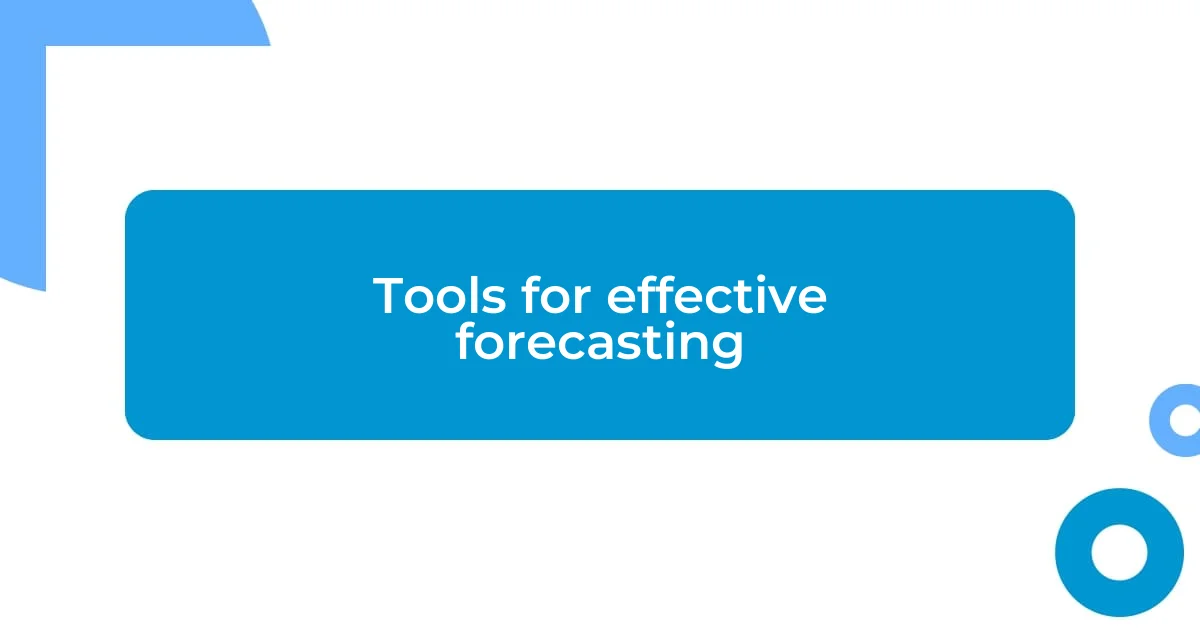
Tools for effective forecasting
To effectively develop a forecasting culture, having the right tools is essential. I’ve found that leveraging software platforms like Tableau and Power BI can dramatically enhance our data visualization capabilities. These tools allow teams to see trends and patterns that might have gone unnoticed in spreadsheets. I remember one instance when a simple graph visualized a dip in sales that encouraged immediate team discussions. How surprising can a visual presentation be in revealing hidden opportunities, right?
Beyond visualization, machine learning algorithms can revolutionize forecasting accuracy. By incorporating these advanced analytical tools, I noticed a significant reduction in our margin of error over time. For instance, when we utilized a predictive model for inventory management, it guided us in placing stock at just the right time. It felt incredible to see our approach evolve from intuition-based to data-driven, making our forecasting process far more robust. Have you considered how embracing technology can reshape your forecasting landscape?
Finally, integrating communication tools like Slack or Microsoft Teams has streamlined our collaboration during the forecasting process. These platforms foster continuous dialogue and feedback, making it easier to stay aligned amid busy schedules. I recall a particularly intense planning session where someone shared a quick update on Slack, prompting a brainstorming burst that led to a breakthrough in our projections. Have you ever thought about how simple communication can spark significant advancements in your team’s forecasting efforts?
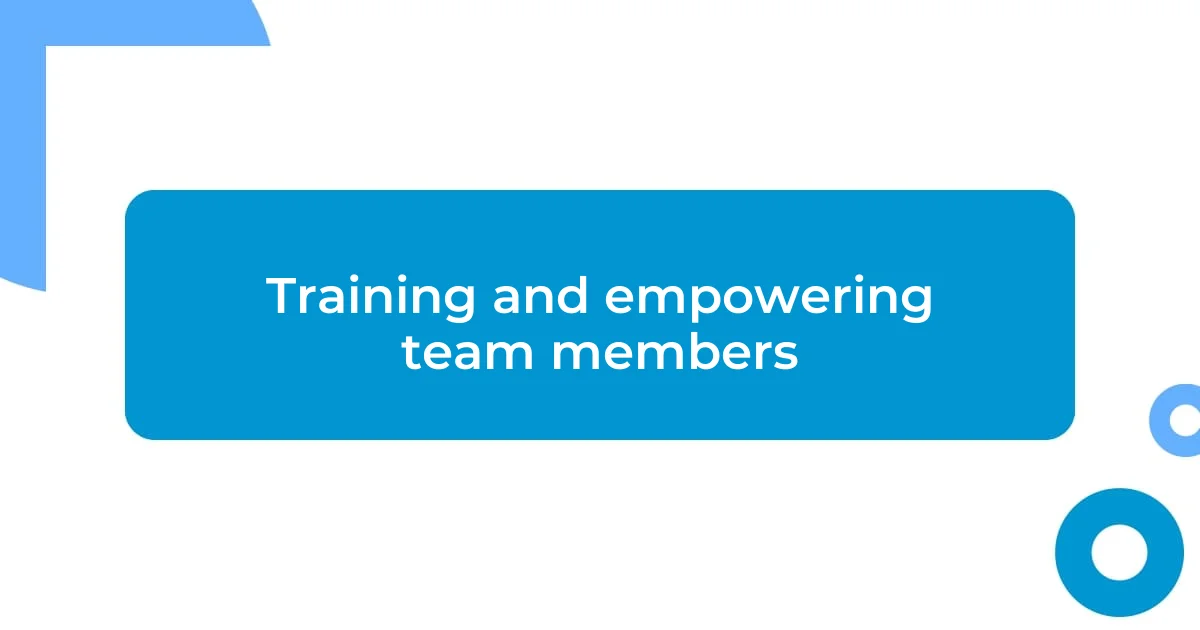
Training and empowering team members
Training team members in forecasting isn’t just about passing on knowledge; it’s about nurturing a sense of ownership and confidence within each individual. I recall a workshop I led where I encouraged the team to develop their own forecasting models. The excitement was palpable as they experimented with different parameters. It was a powerful reminder of how capable we all are when given the right tools and support. Have you seen how that spark of autonomy can motivate people to dig deeper into their roles?
Providing ongoing support is equally important. I made it a point to set aside time each month for one-on-one coaching sessions. This approach allowed me to tailor my guidance to each team member’s unique learning style and needs. I found that these personalized interactions not only clarified complex concepts but also created a safe space for team members to voice their uncertainties. Isn’t it fascinating how individual attention can significantly influence someone’s confidence and competence?
Moreover, celebrating small wins can transform a team’s culture. I’ve found that acknowledging when team members successfully implement new techniques or improve their forecasting accuracy fosters a positive and empowering atmosphere. One such celebration was when a junior analyst presented a significantly improved forecast model to the group. The pride I felt in seeing their growth was immense, and it ignited a collective enthusiasm. How might recognizing achievements contribute to building a more engaged and forward-thinking team?
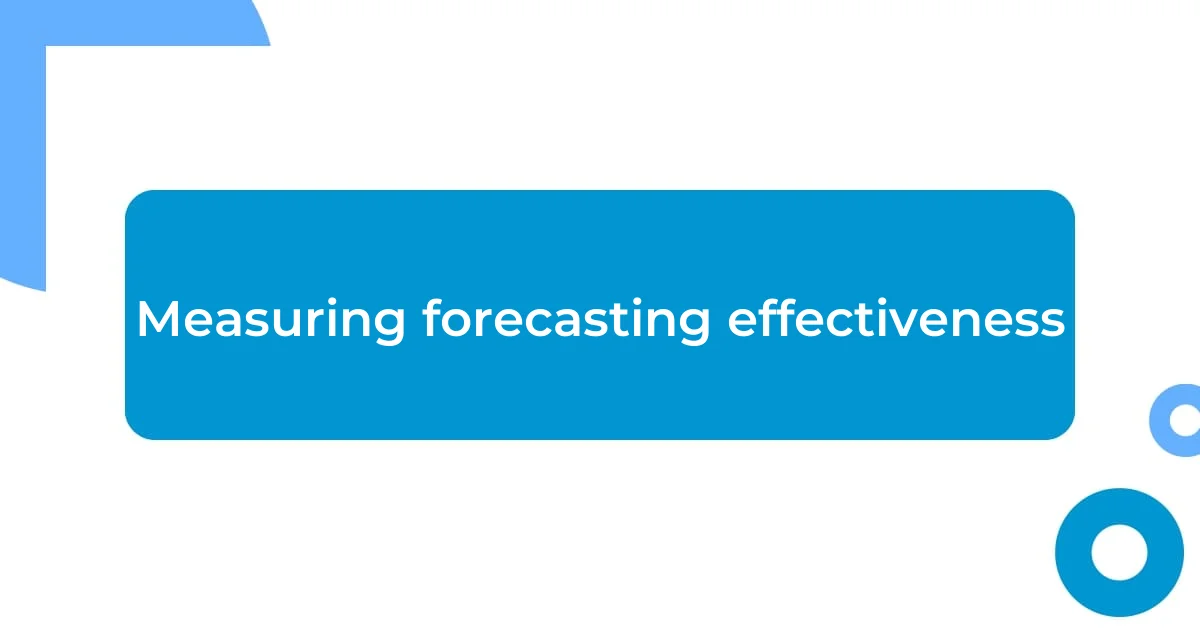
Measuring forecasting effectiveness
Measuring forecasting effectiveness is crucial to understanding how well our models and processes are performing. One way I approach this is through accuracy metrics, like Mean Absolute Percentage Error (MAPE). When I first introduced MAPE to the team, I noticed some skepticism—would a mathematical formula truly capture our efforts? However, as we tracked our forecasts against actual outcomes over several months, seeing tangible numbers made our progress undeniable. It felt like transforming a vague feeling into concrete evidence.
In my experience, interpreting these metrics goes beyond just numbers on a spreadsheet. I remember an intense review meeting where we discussed a particularly inaccurate forecast. Instead of placing blame, I encouraged an open conversation about what went wrong. By analyzing the reasons together, we discovered gaps in data or miscommunication that led us astray. This not only deepened our understanding but also created a culture where learning from mistakes became part of our forecasting journey. Have you ever wondered how discussing setbacks might actually strengthen a team’s capability?
Feedback loops also play a vital role in measuring effectiveness. I often sought input from various departments—sales, marketing, and finance—to assess how our forecasts impacted their strategies. The insights I gained were invaluable; one conversation revealed that a production delay stemmed from a misalignment in our forecasted demand. It was eye-opening to realize how interconnected our efforts were. Engaging with others allowed us to refine our processes dynamically, reinforcing the idea that effective forecasting is truly a collaborative endeavor. Do you see value in fostering such connections to enhance your forecast accuracy?




